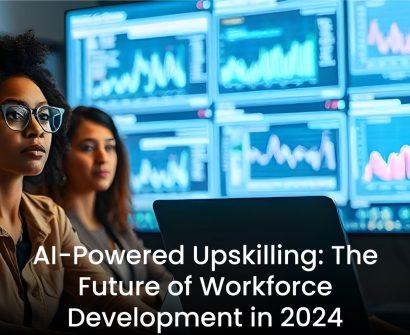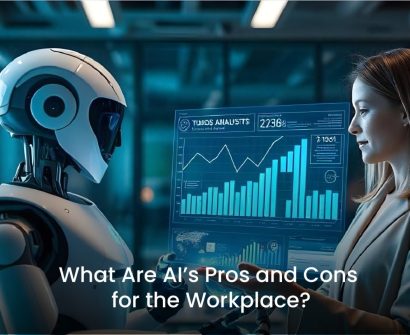
The Positive Impact of AI on the Workforce
Transforming Efficiency, Productivity, and Employee Potential
Artificial intelligence (AI) is transforming modern workers by redefining employment responsibilities, increasing productivity, and inspiring creativity in previously unimaginable directions. AI increasingly complements our job, automating tedious tasks, offering insights, and enabling chances for people to concentrate on significant, value-driven activities instead of replacing human talents. A study estimates that by 2030 AI might increase world GDP by up to 14%. The effect on worker dynamics gets exponentially larger as more businesses use AI. Let’s investigate how AI is improving the workplace of today and generating positive knock-on effects across several sectors.
How AI Enhances Workforce Productivity
1. Enhancing Efficiency and Productivity
Automating Repetitive Tasks
AI shines in managing time-consuming, repetitious chores, freeing workers to concentrate on more strategic and creative work. AI-powered systems may handle data input, scheduling, and answering frequent consumer questions among other tasks. For example, chatbots manage large amounts of consumer service questions so that staff members may concentrate on more difficult client demands and strategic responsibilities. This change improves the working environment for staff members and offers clients flawless services.
Here we will discuss some of the most notable ways AI is changing staff development and the main advantages it presents.
Data-Driven Decision Making
AI technologies examine enormous amounts of data to provide very fast and accurate actionable insights. Predictive analytics enabled by artificial intelligence find patterns in finance and human resources, therefore enabling executives to make faster, better decisions. For example, human resources departments utilize AI algorithms to analyze employee engagement trends and handle turnover issues proactively. This data-driven strategy enables businesses to remain real-time competitive and responsive.
Boosting Overall Productivity
Integrating AI into processes has demonstrated a clear increase in output. Companies that use AI-powered customer assistance, for example, respond faster and with better resolution rates. This development benefits not just the bottom line but also the workforce’s engagement and more satisfied consumers.
2. Enabling New Skill Development and Job Creation
Reskilling and Upskilling Opportunities
Particularly in data analysis, machine learning, and AI-human cooperation, AI’s automation of ordinary jobs fuels the need for new skill sets as well. To equip staff members for positions improved by artificial intelligence, companies are funding reskilling and upskill initiatives. This strategy guarantees workers remain competitive and change with the times regarding their employment.
Emerging Job Roles
As AI has grown, new job categories have emerged. Among the positions arising in reaction to AI developments are those of data scientists, AI trainers, and experts in artificial intelligence ethics. These positions demonstrate the impact of AI in various fields, thereby opening up new career paths and contributing to an increase in employment.


Support for Continuous Learning
AI-driven training systems, using algorithms to customize learning routes based on each person’s pace, progress, and preferences, are revolutionizing employee education. AI-powered platforms like Coursera provide tailored courses that let workers study in fields of interest or necessity, therefore increasing their knowledge and offering chances for personal development.
3. Improving Work-Life Balance and Job Satisfaction
Flexible Work Environments
Tools driven by AI permit remote and flexible work settings. Tools for communication, job management, and teamwork enable teams to operate asynchronously—that is, beyond the confines of a conventional 9–to–5 office arrangement. Employee retention and happiness both depend much on this adaptability.
Reduced Employee Burnout
Through pattern analysis of performance, communication, and workload, AI aids in early identification of employee stress and burnout. These revelations help managers to modify their workloads and handle possible problems before they become more prominent. This proactive approach creates a better, more sustainable workplace that benefits both workers and the company.
Enhanced Job Satisfaction
AI lets workers concentrate on activities they find meaningful and intriguing by automating boring ones. Research indicates that workers engaged in innovative, challenging jobs rather than repetitious ones are more content and effective. Essentially, artificial intelligence tailors the workplace to align with individual interests and skills.
4. Enhancing Workplace Safety and Compliance
Safety Monitoring in Hazardous Industries
AI systems continually monitor equipment and environmental conditions in sectors such as manufacturing and construction, thereby instantly spotting possible safety hazards. Through alerting teams to problems before they become risks, predictive maintenance and AI-powered monitoring solutions lower accidents and improve safety.
Ensuring Compliance
Particularly in highly regulated sectors like healthcare and banking, artificial intelligence technologies simplify compliance by tracking rules and detecting disparities in real-time. AI can quickly adjust to changing rules and guarantee that businesses stay compliant, therefore lowering the risk of fines and preserving operational integrity.


5. Fostering Innovation and Creativity
Augmenting Creativity
In creative spheres, artificial intelligence is a wonderful friend. In advertising, for instance, AI techniques help generate ideas based on consumer behavior patterns and preferences, facilitating brainstorming. In product creation, too, AI examines market data to point up opportunities and gaps, thereby motivating teams to create with more confidence.
Encouraging Experimentation
Companies may rapidly evaluate new ideas or products using AI-driven data, therefore lowering the risk and expense associated with them. This capacity enables companies to test novel ideas and react flexibly to changes in the market, thereby fostering creativity all around.
AI’s Positive Impact on the Workforce
Healthcare: Faster and more accurate diagnosis of illnesses made possible by AI lets experts concentrate on patient care. Watson of IBM, for example, helps evaluate medical information and recommend therapies, hence improving doctor productivity and patient results.
Retail: Retailers such as Amazon use AI for consumer suggestions and inventory control, therefore enabling staff members to provide individualized client encounters. Enhanced customer service and sales follow from this.
Manufacturing: AI-powered robots do very precise, repetitive operations in factories, hence lowering mistakes and accelerating output speed. Then free to control and maximize the production process, employees help to increase work satisfaction and output.
Explore global studies on AI’s impact on workforce development
Addressing Concerns and the Future of AI in the Workforce
Tackling Job Displacement Myths
Although some worry that AI might cause job displacement, research indicates that AI is more likely to enhance than replace human professions. While AI manages daily chores, people are still indispensable for positions needing emotional intelligence, creativity, and strategic thinking. Employees will be urged to acquire complementing abilities as artificial intelligence expands, thereby producing a workforce that excels in human-machine cooperation.
Preparing for the AI-Driven Future
Companies and staff members both have to embrace constant learning and adaptation if we are ready for an AI-enhanced future. Encouragement of adaptability and skill development guarantees staff members are ready to maximize AI and support a creative, future-oriented workforce.
Conclusion
AI is changing the workforce and offering hitherto unheard-of advantages in many different sectors. From promoting efficiency to stimulating creativity, AI offers great promise for transforming our work environments. The workforce is expected to be even more creative, efficient, and job satisfied as businesses keep properly incorporating AI. Future employment seems to be dynamic and full of possibilities depending on ongoing cooperation between people and artificial intelligence. See how AI can transform your workforce today!








